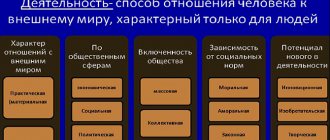Interiorization is the process of forming the structures of the human psyche through the acquisition of life experience. The concept comes from the French “interiorisation”, which means the transition from outside to inside, and from the Latin “interior”, which means internal. The term interiorization itself and synonyms for it are very rare. This is a specific term, often used only in the appropriate context. Therefore, there are no synonyms for the word interiorization as such, and only in rare cases is it used together with the word “transition”, which means, accordingly, the transition from external to internal.
Before a certain complex action is assimilated by the human mind, it is realized from the outside. Thanks to internalization, people can talk about themselves, introduce themselves and that it is very important to think to themselves without disturbing others.
Social interiorization means borrowing the basic categories of individual consciousness from social experience and ideas. This state is expressed in the ability of the human psyche to operate with images of any objects that are not in the field of vision at the moment. These can be objects, objects, phenomena, events with which a person has ever interacted, or he can imagine something that he has never even seen, construct events that can happen, or once happened. A person can go beyond the boundaries of a given moment, events can move in the past and future, in time and space.
The concept of internalization is characteristic only in relation to people; animals do not have such an ability, their brain does not have the opportunity to go beyond the existing situation. The instrument of internalization is the word, and the means of transition from situation to situation is speech action. The word identifies and records the most important properties of things and the methods developed by human practice by which information is processed. Human behavior goes beyond the influence of the external situation that previously determined the behavior of the animal. The correct use of words contributes to the assimilation of significant properties of things, phenomena and methods of information management. Thanks to the process of interiorization, a person, with the help of words, is able to adopt the experience of all humanity, as well as previous generations, or the experience of unknown people, hundreds and even thousands of kilometers away. In Russian science, Vygotsky was the first to introduce this term. He believed that all functions of the human psyche are formed as external, social forms of communication between people in the form of work or other activities.
Vygotsky understood the concept of internalization as the transformation of external actions into a person’s internal conscious plan. The development of the psyche begins from the outside under the influence of social factors existing in society. Collective forms of activity are built into human consciousness through internalization and become individual. After Vygotsky, Halperin began studying this phenomenon and made it the basis of systematic, step-by-step education. Nietzsche understood this concept in his own way. He said that instincts that do not come out, still manifest themselves, but from the inside - this is what he called interiorization.
Activity structure
Human activity has its own structure: motive, methods and techniques of activity, goal and result; It is also necessary to distinguish the subject and object of activity in the structure of activity.
The subject is the one who carries out the activity; the object is what it is directed at. The role of the subject in psychological activity is key in the subjective activity theory of S.L. Rubinstein and in the psychological theory of activity of A.N. Leontyev. The subject in the broadest sense of understanding is all of humanity. In a narrower sense - a specific person and the characteristics of his psyche. An activity is always the activity of a subject (more precisely, a joint activity of subjects), since in the process of mastering the means of communication (speech, writing) and the activity itself, a person always uses the experience of generations...
Motives are the internal drives of a person that force him to perform a particular activity. It is the motive that gives the activity a certain specificity in terms of the choice of ways and means to achieve the goal. Motives can be various needs, interests, attitudes, habits and emotional states. A variety of activities gives rise to a variety of motives. People approach their activities differently, depending on their motives. In the psychological theory of activity, the object is its real motive. There is no such thing as activity without motive. The so-called “unmotivated” activity is not activity without a motive, but activity with an objectively or subjectively hidden motive.
Methods and techniques are the actions that a person takes to achieve the goals of an activity. Methods and techniques for achieving results in activities may consist of one or more operations.
Goals are the most significant objects, phenomena, tasks and objects for a person, the achievement and possession of which constitute the essence of his activity. …Human activity…is conscious and purposeful. In it and through it, a person realizes his goals. A goal is the result of an activity. Goals can be near and far, personal and public, depending on the importance a person attaches to them and what role his activities play in public life.
The result is what a person achieves in the process of activity. The results may not coincide with the goals of the activity.
The phenomenon of catalytic exteriorization
This theory belongs to Carl Gustav Jung, who studied the phenomenon of random coincidences for a long time, deeply, and with a serious scientific approach. As a result, many cases of “coincidences,” “previsions,” and manifestations of intuition were described. For example, this could be the ability to anticipate a call from a loved one. In this case, the thought that appears about communicating with a specific person will soon “materialize” into a real call from him. Jung gave this phenomenon the name “synchronicity.” The origin of such phenomena is said to be that the emotional cycles of loved ones are often well synchronized. The psychologist scientist uses the same phenomenon to explain the emergence of the same inventions (for example, radio) in different parts of the globe almost simultaneously. This example is explained by the large amount of accumulated knowledge that is equally available to scientists in different countries and allows them to make a specific discovery. Without a mystical approach, synchronicity is explained:
- a certain amount of attention and attentiveness, the ability to notice new trends and patterns behind simple coincidences (for this you need to have systems thinking), the ability to listen, hear, analyze and remember;
- skillful use of external random stimuli to solve one’s own creative problems;
- high development of empathy;
- developed skill of projective visualization, which leads to self-motivation and active actions to bring the desired result to life.
Interesting! The concept of exteriorization of sensitivity refers to theories that are more about magic than about psychology. This term refers to the transfer of the body’s sensitivity outward, into the surrounding biofield or onto any foreign objects. This phenomenon is used to explain “bewitchment for love,” “hexing,” causing harm with the help of any objects (photos, wax dolls, etc.) “saturated with the sensitivity of the object,” etc.
The processes of exteriorization and interiorization permeate the entire life and daily activities of every person. In study, work, creativity, and in everyday life, both of these processes are inevitably present. Without exteriorization, learning and creativity, the creation of material objects and the solution of all kinds of problems are impossible; human development and his full existence in society are impossible.
Internal activities, external activities, their relationship
All activities include both internal and external components.
Currently, external and internal activities are increasingly intertwined and interconnected: Physical labor, which carries out the practical transformation of material objects, is becoming more and more “intellectualized,” including the performance of complex mental actions; at the same time, the work of a modern researcher, specifically cognitive, mental activity, is increasingly filled with processes that are external in their form of action.
The activity approach operates on the “principle of the unity of external and internal activities.”
Internal activity, arising from external practical activity, is not separated from it and does not stand above it, but retains a fundamental, two-way connection with it. Internal (mental, mental) activity in its origin is derived from external (objective) activity. At first, objective actions are performed, and only later, with the growth of experience, a person acquires the ability to perform externally directed actions in the mind in order to transform objective reality through reverse transformation (exteriorization). The process of transforming external, object-oriented actions into internal, mental actions is called internalization. The transition from an internal, mental plan of action to an external plan of action, implemented in the form of techniques and actions with objects, is called exteriorization. The inextricable connection between internalization and externalization expands a person's cognitive abilities; a person acquires the ability to operate with images of objects that are outside his field of vision.
Areas of application
Interiorization is most often used in the educational process, when a teacher needs to teach a child to perform various mental actions. It is also used in the process of education: the child develops mental actions regarding correct behavior in society.
In adult life, internalization can also be used in relationships between superior and subordinate or between mentor and trainee.
Interiorization and exteriorization
The activity approach considers interiorization and exteriorization as mechanisms for assimilating socio-historical experience. The idea of the emergence of internal (internalization) mental activity, the activity of human consciousness from external, practical activity arose through the study of socio-historical experience. Human activity - work, learning, play - is associated with cooperation in work, with the use of tools, with the creation of socially significant products. The transfer of social experience is impossible without its expression in external form: in speech, demonstration. Thanks to this, a person “absorbs” the experience of generations. And this is not just copying, the translation of external activity into internal, this is the process of forming consciousness, consciousness as co-knowledge - knowledge that is common, shared with others, separate from them, knowledge perceived by one person as known to others.
The transformation of external, practical activity into internal, mental activity, into the activity of consciousness, is called internalization. Internalization is a transition in which processes that are external in form, with external, material objects, are transformed into processes that occur on the mental plane, on the plane of consciousness; here they undergo a specific transformation - they are generalized, verbalized, reduced, and most importantly, they become capable of further development that goes beyond the limits of possible external activity.
J. J.J. Piaget briefly outlined the concept of internalization - “the transition that leads from the sensorimotor plane to thinking.”
The process of transforming internal, mental activity into external, practical, subjective activity is called exteriorization. Exteriorization is the process of generating external actions, statements, etc. based on the transformation of a set of internal structures formed on the basis of the internalization of a person’s external social activity.
The principle of unity of the external and internal structure of activity, the principle of internalization - externalization is considered in the activity approach, as already noted, as a mechanism for assimilating socio-historical experience.
Cheat sheet on general psychology | Page 1 | Online library
Yulia Mikhailovna Voitina
Cheat sheet on general psychology
1. PSYCHOLOGY AS A SCIENCE: SUBJECT OF STUDY, TASKS
Since ancient times, the needs of social life have forced a person to distinguish and take into account the peculiarities of the mental make-up of people. The idea of the inseparability of the soul and the living body, which was put forward by the great philosopher Aristotle in his treatise “On the Soul,” became the basis for the development of psychology. Thus, psychology initially acted as a science of the soul.
The word “psychology” was formed from the Greek words “psyche” (soul) and “logos” (teaching, science), and it first appeared in the 17th century. in the work of the German philosopher Christian Wolf.
Let us note the main stages in the development of psychology as a science.
Stage I – psychology as a science of the soul (more than 2 thousand years ago).
Stage II – psychology as a science of consciousness (since the 17th century in connection with the development of natural sciences).
Stage III – psychology as a science of behavior emerges in the 20th century. The task of psychology is to set up experiments and observe what can be directly seen, namely, human behavior, actions, and reactions (the motives causing the actions were not taken into account).
Stage IV – modernity – psychology as a science that studies objective patterns, manifestations and mechanisms of the psyche. Psychology studies the inner world of subjective (mental) phenomena, processes and states, conscious or unconscious of the person himself, as well as his behavior. Thus, over time and the development of science, the understanding of the subject of psychology has changed.
At the present stage of development of psychology, the subject is man as a subject of activity, the systemic qualities of his self-regulation, the patterns of formation and functioning of the human psyche, his ability to reflect the world, cognize and regulate his interaction with it.
Thus, the basic principles of psychology were formed:
1) recognition of the causality of mental phenomena by material reality;
2) the study of mental phenomena in development;
3) recognition of the inextricable relationship between the psyche and activity;
4) study of the human psyche, taking into account the relationship of biological and social factors. The tasks of psychology mainly boil down to the following:
1) learn to understand the essence of mental phenomena and their patterns;
2) learn to manage them;
3) use the acquired knowledge to improve the efficiency of people in various fields of practice, as well as to improve the mental health, satisfaction and happiness of people in their daily life;
4) be the theoretical basis for the practice of psychological services. Psychology has connections with and contributes to the development of many other sciences;
5) by identifying the patterns of personality formation, psychology assists pedagogy in the correct construction of the educational process.
2. PLACE OF PSYCHOLOGY IN THE SYSTEM OF SCIENCES
In this question, we will look at the basic sciences that are somehow related to psychology.
The object of research in psychology is a person. But a person, if considered from the point of view of an object, can be considered from various sides: as a biological object, as a social being, as a bearer of consciousness. Despite this, a person is individual. The above may explain why modern psychology is very closely related to other sciences.
Let's consider the basic sciences that are closely related to psychology and influence its development.
First of all, this is philosophy. This is explained by the fact that for a very long time psychology was part of philosophy and only later became an independent science. But this did not destroy the connection between these two sciences. And now there are a number of problems that are considered from the perspective of both psychology and philosophy.
In second place is sociology. Here we can see the commonality in the development of sciences at the level of research methodology. Sociologists use knowledge from social psychology, such as methods for studying personality and human relationships.
In addition, there are many issues that psychologists and sociologists jointly solve. Such problems include: relationships between people, national psychology, psychology of economics and state politics. This also includes problems of socialization and social attitudes, their formation and transformation.
In the above sciences, one can observe the interweaving of various topics of study. If we talk about an example, in social and developmental psychology the concept of social learning, which was developed by sociologists, is very widely applicable. Conversely, theories of personality and small group developed by psychologists find wide application in sociology.
Of course, the sciences of psychology and pedagogy are closely related. This can be explained by the fact that the upbringing and training of children cannot fail to take into account the psychological characteristics of the individual.
Another subject with which psychology is associated is history. One of the well-known examples of the relationship between history and psychology is the use of the historical method in psychology.
To summarize, psychology is closely related to the social sciences.
But in modern times there is also a connection between psychology and technical sciences.
This can be explained by the fact that a person is a participant in technological and production processes.
There is a connection between psychology and the medical and biological sciences. The connection between psychology and these sciences is due to the dual nature of man as a social and at the same time biological being.
This is explained by the fact that the knowledge obtained by physiologists and biologists is used in psychology in order to better understand certain mental phenomena.
To summarize what has been said, we can conclude that psychology is associated with various areas of science and practice, regardless of whether they were previously united, for example, philosophy and psychology, or developed separately, for example, psychology and pedagogy, but due to the coincidence of the issues being studied, they are closely united.
3. HISTORY OF THE DEVELOPMENT OF PSYCHOLOGICAL KNOWLEDGE. FIRST STAGE
Psychology has gone through a certain development path, which was divided into four stages. In this question we will consider the first stage of the development of psychology.
The first stage is characterized as the stage of the science of the soul.
During this period of development of psychology, the human psyche was considered as something primary, existing independently of matter. This can be easily explained: at that time people had practically no knowledge about the structure of the body, therefore they believed that the soul, the spirit of a person is something supernatural and is given to a person from above, while the soul is given to a person at birth and leaves him at death, and also during sleep.
It was believed that the soul has the form of a subtle body or being that lives in all human organs. Later, in connection with the development of religious views, the soul began to be perceived as a double of the body, as a disembodied and immortal spiritual entity associated with the “other world”, where it dwells forever, leaving a person. It was on this basis that various idealistic systems of philosophy arose and developed. The most prominent representatives of this trend are the philosophers of the Pythagorean school from the island of Samos.
The materialistic understanding of the psyche differs from idealistic views in that from this point of view the psyche is a secondary phenomenon, derived from matter. However, the first representatives of materialism were very far in their interpretations of the soul from modern ideas about the psyche. Thus, Heraclitus (530–470 BC), following the philosophers of the Milesian school - Thales, Anaximander, Anaximenes - speaks about the material nature of mental phenomena and the unity of soul and body. According to his teaching, all things are modifications of fire. Everything that exists, including the physical and mental, is constantly changing.
Not only Heraclitus revealed the idea of fire as the basis of the existence of the world, this was also found in the works of the ancient Greek thinker Democritus (460–370 BC). It was he who was the creator of the atomic model of the world.
Aristotle (384–322 BC) saw the concept of soul as much more complex. “On the Soul” is his first treatise, which is a special psychological work, which for a long time was the main guide to psychology. Consequently, Aristotle can rightfully be considered the founder of psychology.
Activities and mental processes
In activity... all the mental qualities of a person are not only manifested, but also formed. The activity is organically connected with the problem of personality development. Personality is formed, manifested and improved in activity. This is where consciousness is formed.
Mental processes: Perception, attention, imagination, memory, thinking, speech are the main components of human activity. Without the participation of mental processes, human activity is impossible: a person must imagine what to do, remember, think, make judgments. Mental processes are not just involved in activity, they develop in it, and themselves represent special types of activity.
Perception in the process of practical activity acquires its basic human characteristics. Its main types are formed in the process of activity: Perception of depth, direction and speed of movement, time and space. The child's manipulation of three-dimensional, near and far objects gives the perception of the object's dimensions: width, height, depth. This teaches you to perceive and evaluate forms.
Imagination is also associated with activity. Only through experience and practical activity is a person able to imagine or think. Imagination is a reflection of the experience of practical activity.
Memory and its two main processes - memorization and reproduction - are directly related to practical activity. Memorization is carried out in activity and is the activity itself, which includes actions and operations aimed at preparing material for memorization - this is structuring, understanding, associating the material with known facts, and so on. Memorization also involves performing certain actions aimed at timely and accurate retrieval of material stored in memory. And reproducing the activity makes the search process easier.
Thought, in a number of its forms, is identical to practical activity (the so-called “manual” or practical thinking). In its more developed forms - figurative and logical - the active moment is presented in it in the form of internal, mental actions and operations. Speech is also a special type of activity.
An example of interiorization in psychology
The process of internalization in psychology can be clearly seen in the example of a child who assembles a sorter. First, the adult shows him and says: “A round figurine goes into a round hole, an asterisk goes into an asterisk.” Then the baby says the same thing out loud to himself and performs the action. At the next stage, he pronounces the necessary actions only mentally. At the last stage, he quickly matches the figures with the holes and successfully performs the actions at high speed, without thinking, and without errors.











